NVG stands for Night Vision Goggles, which is a catch-all term to describe wearable devices that help one see in the dark.
So, you finally took the plunge and got into the NVG game. Congratulations. Of course, if you’re serious enough about preparedness and personal defense to spring for NODs, you already know that gear doesn’t do much good without practice and training. But, where to begin? Fortunately, there’s a growing number of firearms training facilities offering night fighting courses that cover things like shooting under NODs, passive aiming, using IR lasers and illuminators, team tactics and land navigation. But, to get the most out of your night vision goggles and operator course it pays to learn some basics up front. While not everyone can afford a PVS 31, there are other single and dual tube devices coming to market at (comparably) low prices.
Spec Ops Gear: Get Good with NODs
As someone who aspires to be a well-trained and properly equipped civilian, I myself am still relatively new to tactical night vision training. Welcome to Spec Ops Gear, I am not military or law enforcement. I am a citizen who believes that skill and training are integral to responsibly exercising our 2nd amendment rights. To that end, here’s a few things I did to practice up on some NVG Operator stuff outside of tactical training courses so I can get good with NODs.
- Enter a Night Match
-
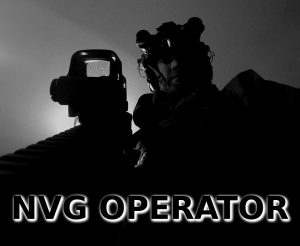
Even though entering a night match is not your first step when you’re new to seeing in the dark, it’s probably one of the best. Competitive shooting is the best way for civilians to “get good.” Public ranges won’t let you shoot on the move or usually even draw from a holster, let alone run & gun. Furthermore, due to cost and time, you may only be able to attend a few tactical training courses per year. But, you can enter shooting competitions on a monthly or even weekly basis depending on how much free ammo and time you have. No, 3 gun is not a perfect analog to fighting bad guys. Even still, for a $25- entry fee you can get an entire day of shooting on the move with your rifle and pistol (you can enter a category that doesn’t require shotgun). With the exponential rise in civilian tactical training, multigun matches are now sometimes held in low light conditions. This means you’ll get a chance to shoot on the move with a weapon light, IR laser, NVG etc at a dedicated shooting venue. For $20-30 bucks entry fee plus your ammo, multigun is the cheapest live fire practice you can get.If you’re going to spend $500- on a low light tactical training course, then $25- per event to enter some multigun competitions and a few night shooting competitions is an easy “YES.”
- Practice Firearms Manipulations With Night Vision On
-
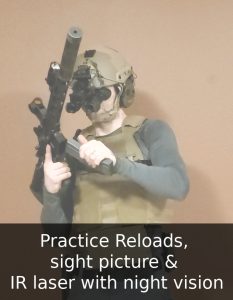
Practice your reloads, sight picture & IR laser use
When you get to your expensive NVG tactical training course, don’t waste precious class time on basic gun handling. Show up already knowing the basics so you can focus on the truly valuable parts that you can’t learn at home. Simple tasks are more complicated when NODs are involved. The lenses on your goggles have a focal point which you’d normally want focused at some distance away from you. When objects like targets are in focus, it means that objects that are very close (within arm’s reach) will be out of focus. When you look down at your rifle while using night vision, your rifle will appear very blurry unless you’ve specifically focused your device very close up. But, if you focus on things up close, anything more than 10 feet away will be very blurry.Having your NODs focused on your target is crucial but makes it more difficult to do things like reloading, managing your sling, getting your med kit, controlling optics and operating the various functions of your IR illuminator/laser. You should also know how to operate and adjust your device and its mounting hardware as well. You can practice all of these weapons manipulations off the range at home. By doing your dry fire in advance, you’ll be sure to get the most out of your NVG Operator course and avoid the embarrassment of being unprepared.
You’ll need to be able to quickly and accurately control all of your infrared devices and make sure you don’t mix them up with your visible light settings/devices etc.
Don’t have your NVG yet? Practice your gun/kit handling with a blindfold on to get used to doing essential tasks without seeing them clearly. - Acclimate Your Body to Night Vision
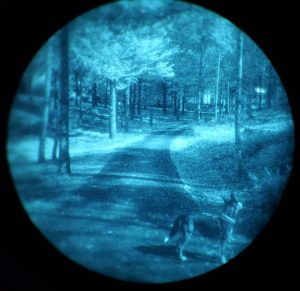
Go Walk The Dog
NVGs restrict your field of view and may have some visual distortion toward the edges of the lenses. Normally, humans see from a 120 degree field of view. Night vision restricts that down to 40-50 degrees. You may not realize how much your brain relies on peripheral vision for completing normal tasks or even walking/running. When I first started using NODs, the restricted field of view and the distortion at the edges of the lenses made me feel a bit nauseated during continuous use. Don’t get me wrong, when I walked out into my backyard with gen 3 white phosphorus dual tube goggles for the first time it was an amazing and exhilarating experience. I saw flying bats casting moonlight shadows on the ground and the stars looked incredible. Nonetheless, if I tried to move around quickly and navigate complicated terrain I found myself feeling a little seasick after 15-20 minutes.The great news is that your body gets acclimated to NVG with repeated use. After awhile, you’ll feel right at home walking around, jogging or hiking on nights so dark you couldn’t see your hand held up right in front of your face with unaided eyes. Give yourself regular night walking sessions, preferably in varying environments. I’ll often just take the dog for a walk in the dark and see the sights. Regularly hiking around using night vision is essential to being absolutely comfortable and effective using your equipment.
Don’t just practice outside. Try going into and out of your home with your goggles on. Navigating enclosed spaces like stairwells quickly may take some time to get efficient at. If you live in the city, be sure to find some dark areas with no street lights to practice in. That way, you’ll have a wider range of experience. If you can find somewhere safe to do so, practice driving with your NODs. With practice, you can drive just fine but for me there was a steep learning curve in this aspect. Use caution with vehicle ingress/egress because your expensive head gear can and will get caught up on the car’s interior as you try to exit.
Whatever you do, just get extremely comfortable wearing NVGs in a wide variety of settings and terrain types.
- Consider Airsoft For Extra Practice
-
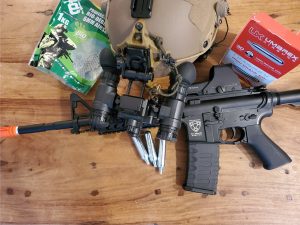
Real Night Vision, Replica Rifle Airsoft used to get a lot of criticism from macho “operators” calling it a “juvenile toy.” But, with guys like Travis Haley and Chris Costa getting on the airsoft bandwagon, times are changing. Do you dry fire? All the best shooters say you should. What if you could combine dry fire with a practice replica that actually shoots non lethal projectiles? What if you could buy an aisoft gun and 5,000 training BBs for less than a case of rifle ammo? What if you could shoot a thousand rounds per week in your garage and/or back yard? What if you could do force on force scenarios defending your actual house and live opponents? With airsoft, you can do all these things.
In many areas, it’s hard to find a good range where you can safely do live fire training at night. In some states it’s illegal to shoot at night so don’t draw unnecessary attention to yourself. Even if you do have a good night shooting spot and go regularly, setting up an airsoft rifle with a NV-capable red dot and/or an IR laser illuminator can greatly expand your ability to train often. If you’re getting into this aspect of the tactical training game, chances are you’re already really good at shooting. Even still, getting reps in under night vision is crucial to becoming effective at shooting stuff in the dark. Airsoft is an excellent way to safely and discreetly practice often.
Since I live on acreage, it’s easy to strap on NVGs and go practice shooting on the move using an airsoft AR15 after the kids are in bed. Even a quick 15 minute session on a week night is well worth it. With airsoft you can also do things that you couldn’t do in live fire except in an emergency: practice shooting inside your house so long as your wife isn’t home. You could practice home defense scenarios in your own home with an airsoft rifle.
Basically, with airsoft you can train just about every day if you have a relatively private backyard, a garage/basement and/or cool neighbors.
- Practice Passive Aiming, A Lot
-
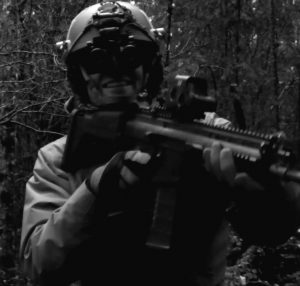
Passive aiming is harder than it looks.
Passive aiming is when you use a holographic or red dot optic in conjunction with your night vision. The reason that passive aiming is becoming more popular is because more and more people are trying to own the night. When you use an active aiming device like an IR laser to aim your gun it also makes you a target to potential adversaries. There are many benefits to IR laser aiming, mainly that it’s much easier because you don’t need a cheek-weld and could even accurately hip shoot your rifle if you wanted to.But, since the IR laser gives away your position to others with night capability, passive aiming has increased in popularity. So why doesn’t everyone just use passive aiming all the time? The answer is that passive aiming can be a lot more difficult because your NVGs need to be perfectly aligned with the rifle optic, which can be harder than it sounds. Sure, you may be able to passive aim on a flat range standing still. But, trying to do passive aiming from a crouched position while using cover can be very difficult at first. With body armor on, I find it very difficult to accurately use passive aiming from the prone shooting position.
You’ll know that your red dot is not aligned to your site because the dot will appear very distorted. On my Aimpoint micro, the dot seems to grow a comet tail when my tubes are misaligned. When I’m misaligned using an eotech, the optic reticle appears blurry and smeared.
The overbore height of the optic needs to be higher than normal as well. The bottom line is that passive aiming takes practice and, while stealthy, it has limitations as well.
NVG Operator Training at Home
None of the above advice would replace high-quality tactical training with night vision from a competent professional. And yet, there’s a lot that we can do as civilians with limited budgets and time constraints to become much more proficient with our equipment. Even if you do go to classes, using the practice ideas we’ve discussed today will still be valuable, because training without continued practice doesn’t do much good.
Stay free!
